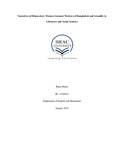| dc.contributor.advisor | Azim, Dr. Firdous | |
| dc.contributor.advisor | Huq, Dr. Samia | |
| dc.contributor.author | Mizan, Raisa | |
| dc.date.accessioned | 2018-04-15T05:50:38Z | |
| dc.date.available | 2018-04-15T05:50:38Z | |
| dc.date.copyright | 2018 | |
| dc.date.issued | 2018-01 | |
| dc.identifier.other | ID 13303015 | |
| dc.identifier.uri | http://hdl.handle.net/10361/9869 | |
| dc.description | This thesis is submitted in partial fulfilment of the requirements for the degree of Bachelor of Arts in English, 2018. | en_US |
| dc.description | Cataloged from PDF version of thesis. | |
| dc.description | Includes bibliographical references (pages 68-70). | |
| dc.description.abstract | The women garment workers of Bangladesh figure highly in our national consciousness. They are undoubtedly the women of the nation. From social sciences to economics to media, their presence is everywhere. They are simultaneously figures of anxiety and figures of celebration. While the news of garment workers’ exploitation in the form of low pay, lack of benefits and paid leave, lack of safe transport, lack of building safety regulations drive us towards a state of anxiety, their achievements in the economic sector make us proud and make us want to celebrate their hard work. However, the garment workers are curiously missing from the realm of literature. It is surprising that the image of the decrepit, fatigued garment worker bending over a sewing machine or the howling, lamenting worker who has lost a limb in a factory accident is rarely portrayed in the pages of literature. Nevertheless, there are a few literary works available which have attempted to encase the woes and the pleasures of the lives of the garment workers. The works that have been used in this paper are Nasreen Jahan’s novel Krush Kathe Konna, Khandokar Masud Rana’s novel Garments Konnar Attokotha and Tahmima Anam’s short story “Garments.” I have used the works of Dina Siddiqi, Petra Dannecker and Naila Kabeer for the social sciences perspective. Although this absence of the garment women from the world of literature can be a legitimate topic for research, this paper is concerned with the narrative differences between the representations of garment workers in literature and social sciences. In the differences between these two discourses, there emerges a disjuncture. This paper talks about the nature of this disjuncture and the reasons behind it. | en_US |
| dc.description.statementofresponsibility | Raisa Mizan | |
| dc.format.extent | 70 pages | |
| dc.language.iso | en | en_US |
| dc.publisher | BRAC Univeristy | en_US |
| dc.rights | BRAC University theses are protected by copyright. They may be viewed from this source for any purpose, but reproduction or distribution in any format is prohibited without written permission. | |
| dc.subject | Garment worker | en_US |
| dc.subject | Women workers | en_US |
| dc.title | Narratives of disjuncture: women garment workers of Bangladesh and sexuality in literature and social sciences | en_US |
| dc.type | Thesis | en_US |
| dc.contributor.department | Department of English and Humanities, BRAC University | |
| dc.description.degree | B.A. in English | |

